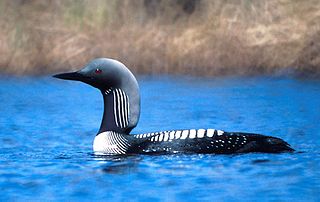
Loons or divers are a group of aquatic birds found in much of North America and northern Eurasia. All living species of loons are members of the genus Gavia, family Gaviidae and order Gaviiformes.

Grebes are aquatic diving birds in the order Podicipediformes. Grebes are widely distributed freshwater birds, with some species also found in marine habitats during migration and winter. Some flightless species exist as well, most notably in stable lakes. The order contains a single family, the Podicipedidae, which includes 22 species in six extant genera. Although, superficially, they resemble other diving birds such as loons and coots, they are most closely related to flamingos, as supported by morphological, molecular and paleontological data. Many species are monogamous and are known for their courtship displays, with the pair performing synchronized dances across the water's surface. The birds build floating vegetative nests where they lay several eggs. About a third of the world's grebes are listed at various levels of conservation concerns—the biggest threats including habitat loss, the introduction of invasive predatory fish and human poaching. As such, three species have gone extinct.

The red-necked grebe is a migratory aquatic bird found in the temperate regions of the northern hemisphere. Its wintering habitat is largely restricted to calm waters just beyond the waves around ocean coasts, although some birds may winter on large lakes. Grebes prefer shallow bodies of fresh water such as lakes, marshes or fish-ponds as breeding sites.

The horned grebe or Slavonian grebe is a relatively small waterbird in the family Podicipedidae. There are two known subspecies: P. a. auritus, which breeds in the Palearctic, and P. a. cornutus, which breeds in North America. The Eurasian subspecies is distributed over most of northern Europe and the Palearctic, breeding from Greenland to western China. The North American subspecies spans most of Canada and some of the United States. The species got its name from large patches of yellowish feathers located behind the eyes, called "horns", that the birds can raise and lower at will.

Podilymbus is a genus of birds in the Grebe family, the genus name is derived from Latin Podilymbus, a contraction of podicipes —the origin of the name of the grebe order—and Ancient Greek kolymbos, "diver".

The rhinoceros auklet is a seabird and a close relative of the puffins. It is the only extant species of the genus Cerorhinca. Given its close relationship with the puffins, the common name rhinoceros puffin has been proposed for the species.

Podiceps is a genus of birds in the grebe family. The genus name comes from Latin podicis, "rear-end" and ped, "foot", and is a reference to the placement of a grebe's legs towards the rear of its body.
The San Diego Formation is a geologic formation in southwestern San Diego County in southern California, and northwestern Baja California (México).
Paleontology or palaeontology is the study of prehistoric life forms on Earth through the examination of plant and animal fossils. This includes the study of body fossils, tracks (ichnites), burrows, cast-off parts, fossilised feces (coprolites), palynomorphs and chemical residues. Because humans have encountered fossils for millennia, paleontology has a long history both before and after becoming formalized as a science. This article records significant discoveries and events related to paleontology that occurred or were published in the year 1990.
Gavia howardae is an extinct species of loon from the Piacenzian age from United States. Fossils of this bird were initially found in 1947 by Clifford Kennell in the San Diego Formation, California and were given a name in 1953 by Pierce Brodkorb. These first specimens consisted of humeri bones, which Brodkorb indicated based on the distal end of the humerus were a smaller species of the genus Gavia, with a possible relationship with the pacific loon. More specimens were collected from the same deposits covering the entirety of the wing, some more complete than others. Chandler (1990) described and published these new materials and found G. howardae to be related to the red-throated loon instead. Additional material has been recovered from the Yorktown Formation, North Carolina where in addition more wing bones, there were also remains of the leg and shoulder regions. Based on the overall size of the remains, G. howardae was on average smaller than the red-throated loon, and one of the smallest species of Neogene loons from North America.

Thiornis is a fossil genus of Middle Miocene grebe known from a nearly complete specimen from Libros, Spain. Originally classified as a type of moorhen, Thiornis has since been classified as a species of grebe. The overall anatomy of the bird is identical to modern grebes. It contains a single species, T. sociata.
Pliolymbus is a fossil genus of grebe known from the Late Pliocene to Early Pleistocene of United States and Mexico. It is known from a single species, P. baryosteus.
Aechmophorus elasson is an extinct species of grebe recovered from the Piacenzian age of the United States.
Podilymbus majusculus is an extinct species of grebe recovered from the Piacenzian age of the United States.
Podiceps csarnotanus is an extinct species of Upper Pliocene grebe from Hungary.
Podiceps oligoceanus is an extinct species of grebe possibly from the Neogene period which the specimen has been found in the United States.
Podiceps dixi is a possible extinct species of grebe from the United States.
Podiceps howardae is a possible extinct species of grebe from the United States, possibly a larger and earlier form of the horned grebe.
Podiceps solidus is an extinct small species of Upper Miocene to Lower Pliocene grebe from Western Mongolia.
Podiceps discors is an extinct species of grebe from the Upper Pliocene of western North America. It was similar to the black-necked grebe.







